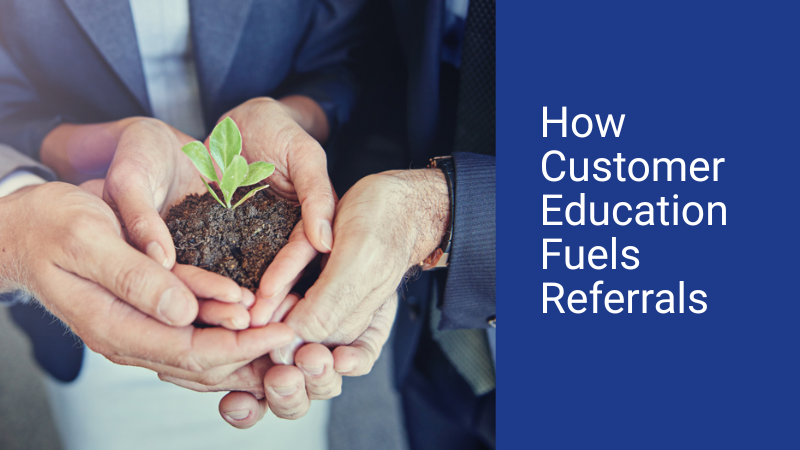Introduction
Today professional service firms face an increasingly complex challenge: building sustainable growth while maintaining strong customer relationships. The solution lies in a powerful yet often underutilised strategy – customer education.
When firms invest in teaching their customers, they create more than just informed customers. They build a foundation for long-term success and sustainable growth. Educated clients make better decisions, achieve superior outcomes, and become natural advocates for your services.
Key Takeaways
- Client education directly impacts referral rates and lifetime value
- Educated clients become natural brand advocates
- Structured learning paths increase engagement and completion rates
- Success requires measuring both quantitative and qualitative outcomes
- Technology enables scalable, personalized learning experiences
Table of Contents
- Introduction
- The Link Between Customer Education and Referrals
- Understanding Customer Lifetime Value (CLV)
- How Education Enhances Customer Experience
- Strategies for Effective Customer Education
- Measuring Impact and Success
- Case Studies in Customer Education
- Tools and Technologies
- Overcoming Implementation Challenges
- The Future of Customer Education
- FAQ’s
- Final Thoughts
The Link Between Customer Education and Referrals
When customers thoroughly understand your services, they become confident advocates for your firm. This confidence stems from their ability to articulate value and explain complex concepts in simple terms to others. The impact extends far beyond basic word-of-mouth marketing – it creates a network of informed ambassadors for your brand.
HubSpot demonstrates this principle effectively through their comprehensive education platform. Their inbound marketing certification program has created a community of over 200,000 informed clients who actively share their success stories. These educated clients naturally become brand ambassadors, driving organic growth through qualified referrals.
Understanding Customer Lifetime Value (CLV)
The true value of customer education becomes clear when examining its impact on Customer Lifetime Value. Salesforce’s Trailhead platform provides compelling evidence of this connection. Their educated customers typically stay with the platform 58% longer than non-engaged users and implement more advanced features within their first year.
This increased engagement translates directly into higher lifetime value. Educated customers better understand the full scope of available services, leading them to explore and adopt additional features over time. They also require less support, reducing service costs while increasing satisfaction.
How Education Enhances Customer Experience
Apple’s “Today at Apple” program exemplifies how education transforms the customer experience. These sessions go beyond basic product training, creating an environment where customers discover new possibilities and build confidence in their skills. The program has served millions across 500 locations, fundamentally changing how clients interact with the brand.

The impact on client experience extends throughout the relationship. Educated clients approach new features with confidence rather than hesitation. They solve basic challenges independently and engage support teams more effectively when needed. This self-sufficiency creates a positive cycle, where each successful interaction builds trust and deepens the relationship.
Strategies for Effective Customer Education
Successful education programs require thoughtful design and consistent delivery. HubSpot’s Academy demonstrates how structured learning paths can guide clients from basic understanding to advanced mastery. Their approach begins with foundational concepts and progressively introduces more sophisticated techniques, maintaining engagement through each stage.
The key lies in making education accessible and immediately valuable. When customers can apply new knowledge to current challenges, they’re more likely to continue learning. HubSpot achieves this by incorporating real-world scenarios into their training, helping customers see direct applications for their new skills.
Personalisation plays a crucial role in maintaining engagement. By offering multiple learning paths, firms ensure each client receives training relevant to their specific needs. This targeted approach has helped HubSpot achieve completion rates 35% higher than industry averages.
Measuring Impact and Success
The success of customer education shows in both numbers and customer stories. Salesforce reports that Trailhead graduates generate 32% more value for their organisations while requiring significantly less technical support. These metrics demonstrate how education drives both customers success and operational efficiency.
Beyond pure statistics, educated customers demonstrate deeper platform understanding and greater confidence in leveraging advanced features. They become more sophisticated users over time, often discovering innovative ways to apply their knowledge to business challenges.
Case Studies in Client Education
HubSpot’s Academy stands as a testament to comprehensive customer education. Beyond certifying hundreds of thousands of professionals, they’ve transformed how clients approach digital marketing. Their graduates consistently report higher campaign success rates and better ROI from their marketing investments.

Apple’s “Today at Apple” program revolutionised retail education by creating immersive learning experiences. These sessions build both skills and community, turning retail locations into educational hubs where customers connect, create, and grow their capabilities.
Salesforce’s Trailhead platform reimagined technical training through gamification and clear progression paths. By breaking complex concepts into manageable modules and rewarding progress, they’ve made learning engaging and accessible for users at all levels.
Tools and Technologies
Modern customer education leverages various digital platforms to deliver knowledge effectively. Learning management systems provide the foundation, offering structured paths for skill development. Video platforms enable dynamic content delivery, while interactive tools facilitate practical application of new knowledge.
Community forums extend learning beyond formal training, creating spaces where clients share experiences and solutions. These peer-to-peer interactions reinforce formal education while building valuable support networks.
Overcoming Implementation Challenges
Every education program faces obstacles, from resource constraints to engagement challenges. Successful firms start small, focusing on core topics that deliver immediate value. They build gradually, using customer feedback to guide program evolution.
Maintaining engagement requires consistent effort and creativity. Regular content updates keep material fresh and relevant. Recognition programs celebrate customer achievements, encouraging continued participation and growth.
The Future of Client Education
As technology evolves, so do the possibilities for customer education. Artificial intelligence promises more personalised learning experiences, while virtual reality could transform how clients practice new skills. Mobile platforms make learning more accessible than ever, enabling clients to learn whenever and wherever suits them best.
Yet the fundamental principle remains unchanged: educated customers become better partners in their own success. They achieve better outcomes, stay longer, and advocate more effectively for your services.
FAQs:
Q: How quickly can we expect to see results from a customer education program?
A: While some benefits, like reduced support tickets, may appear within the first few months, significant impacts on referrals and CLV typically emerge within 6-12 months of consistent program implementation. The key is to establish clear baseline metrics and track progress regularly.
Q: What’s the minimum investment needed to start a customer education program?
A: Start with existing resources: document common client questions, create simple how-to guides, and record short training videos. Many firms begin with basic email sequences and a knowledge base, expanding as they see results and gather client feedback.
Q: How quickly can we expect to see results from a customer education program?
A: Success comes from making content relevant and immediately applicable. Break learning into manageable chunks, celebrate customer progress, and regularly gather feedback to improve. Personalised learning paths and real-world examples keep clients engaged and coming back for more.
Final Thoughts:
Customer education represents a strategic investment in your firm’s future. By helping customers understand and maximise the value of your services, you create stronger, more profitable relationships. The most successful firms recognise that education isn’t just a support function – it’s a core driver of business growth.
Start building your education program today, focusing on clear value delivery and consistent engagement. Remember that every step toward better customer education strengthens your competitive position and builds lasting client relationships.
The future belongs to firms that not only deliver excellent services but also excel at teaching customers to maximise their value. In an increasingly complex business environment, the ability to educate effectively becomes a crucial differentiator for sustainable growth.
Speak soon.
- How Customer Education Fuels Referrals and Maximises Lifetime Value (CLV) - April 4, 2025
- Referral Success: The Art of Long-Term Referral Relationship Building - March 19, 2025
- 10 Rules of Referral Marketing - February 26, 2025

